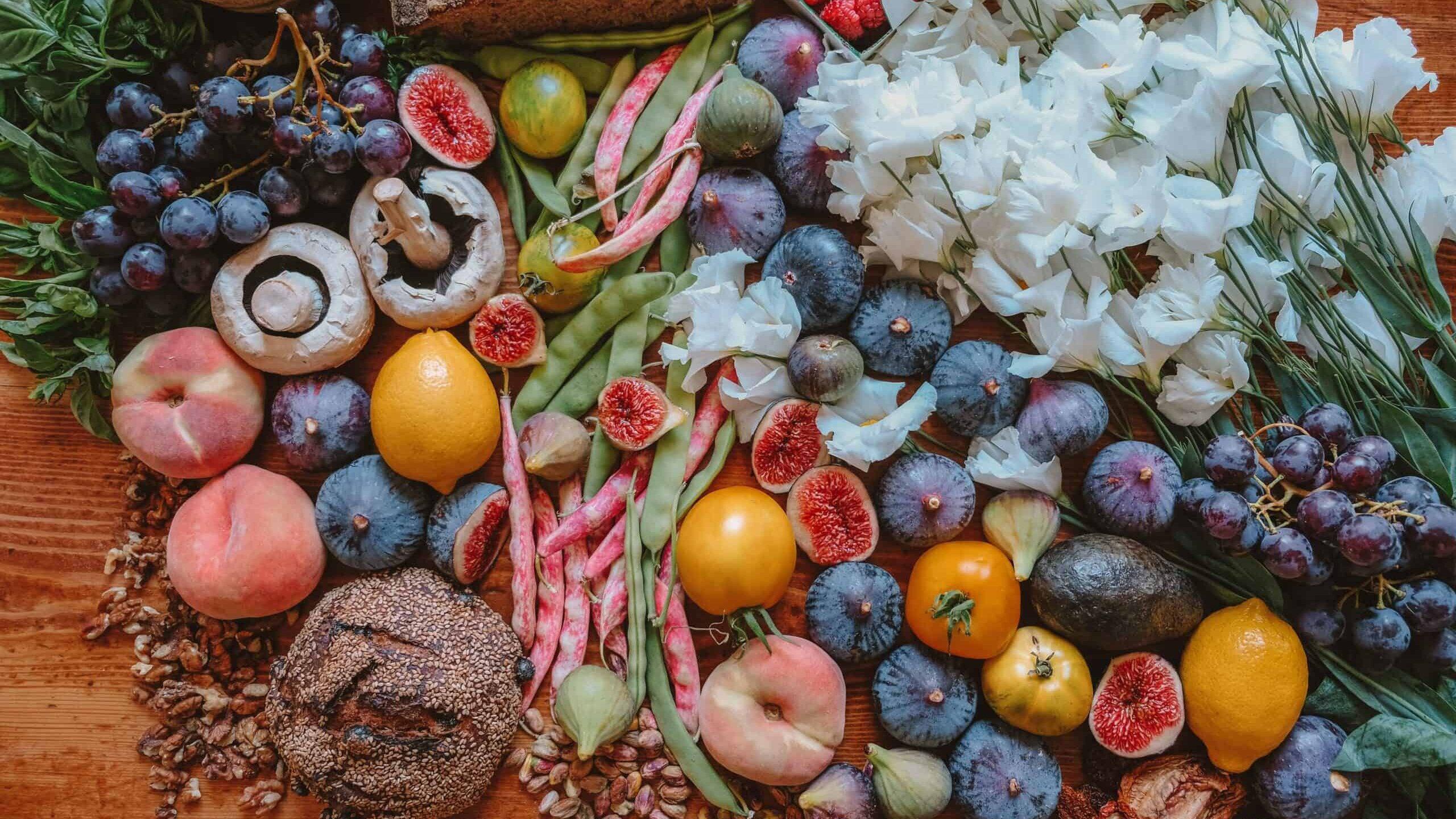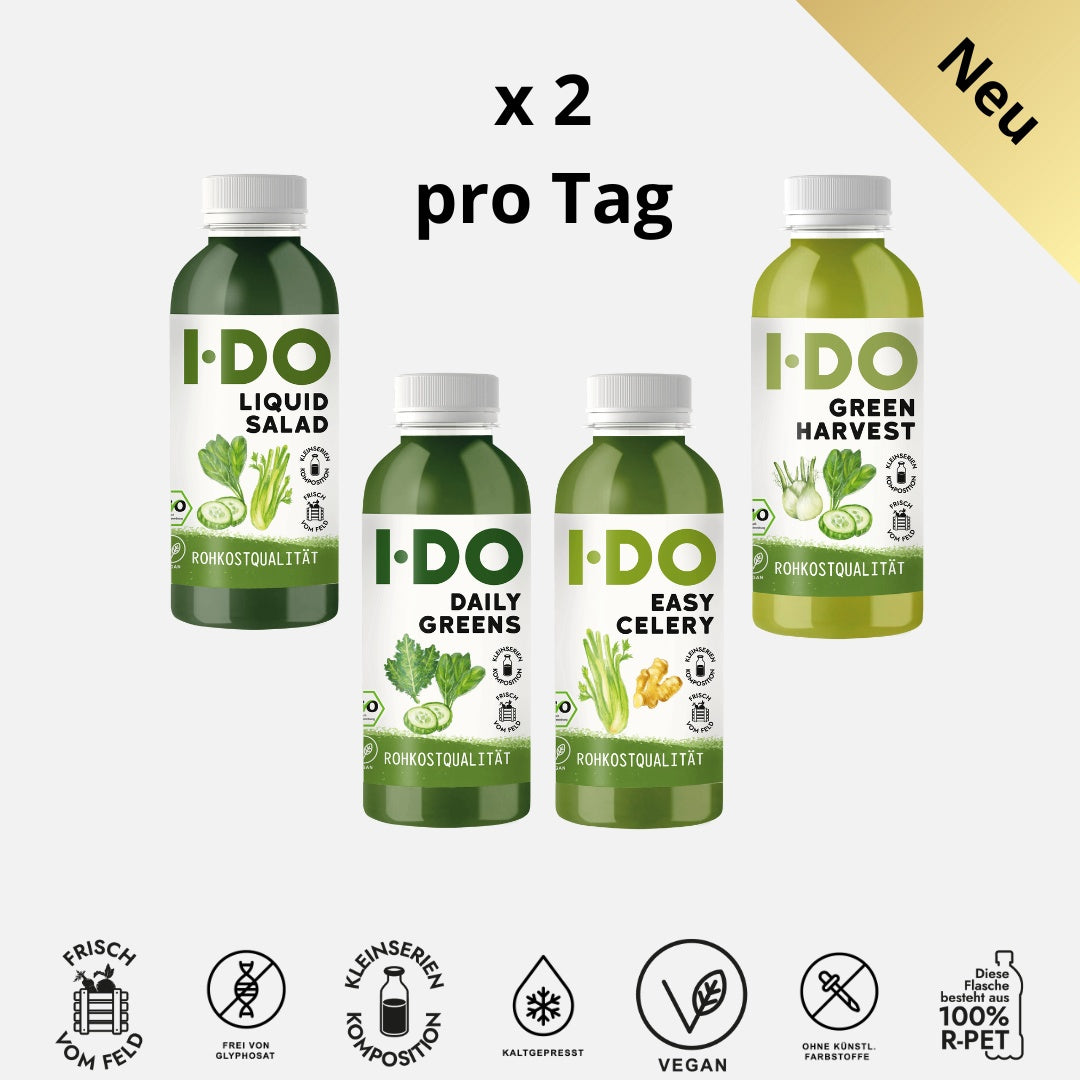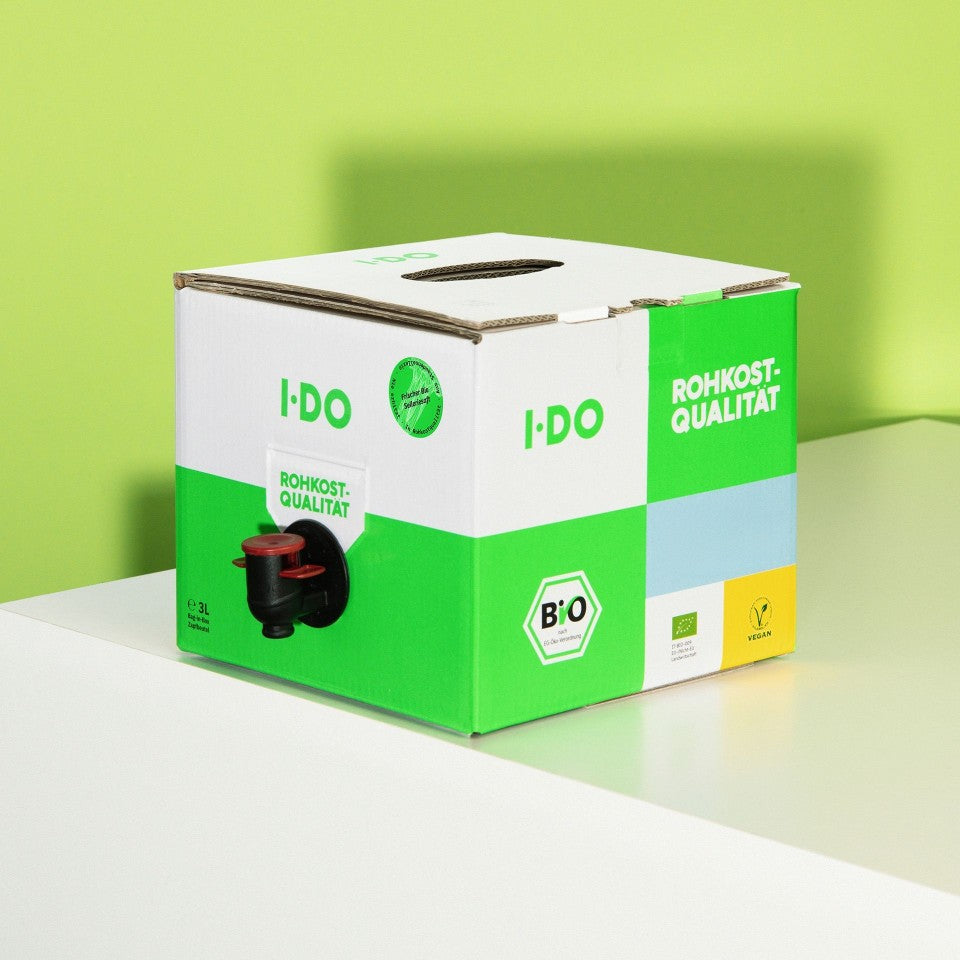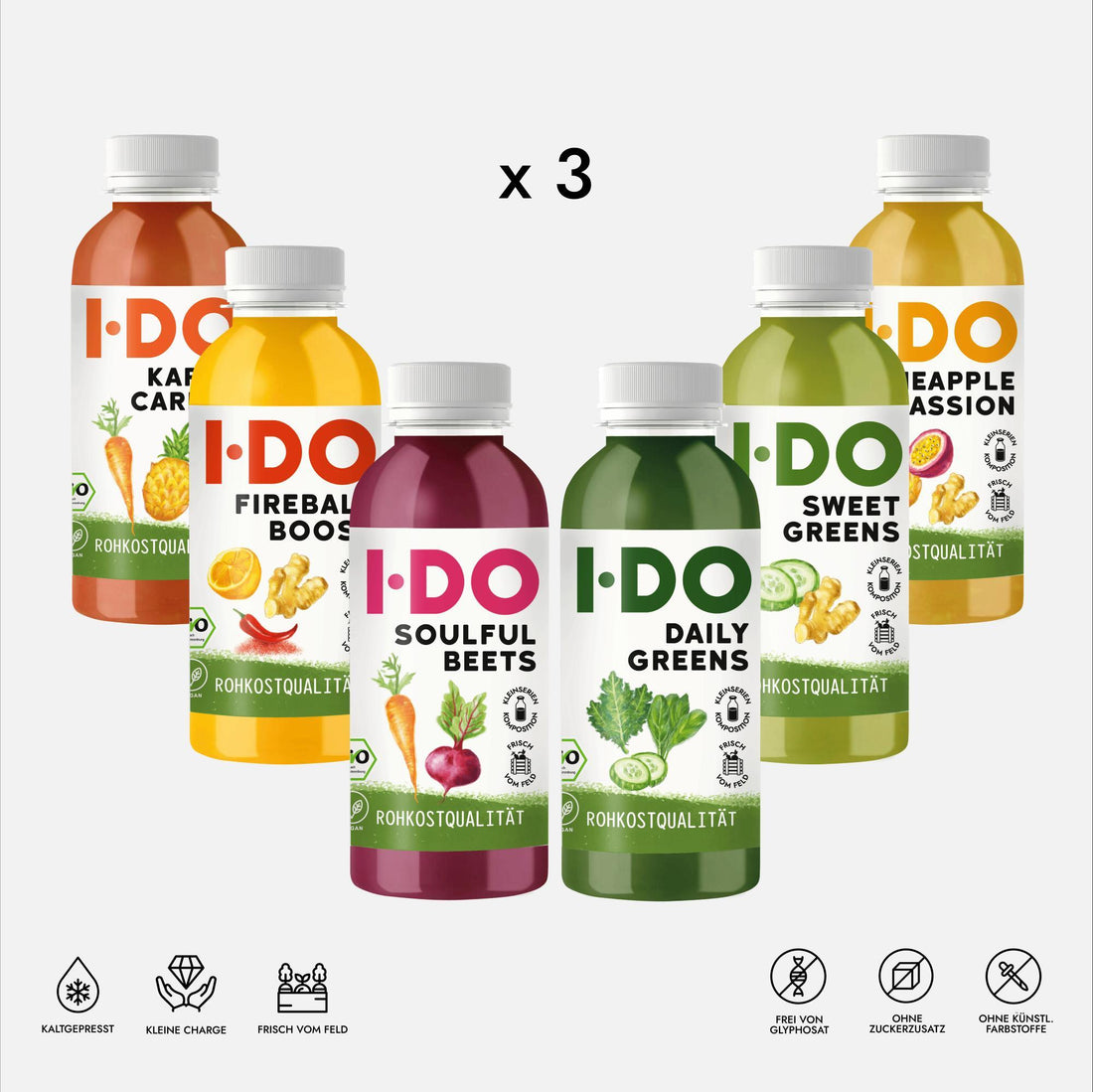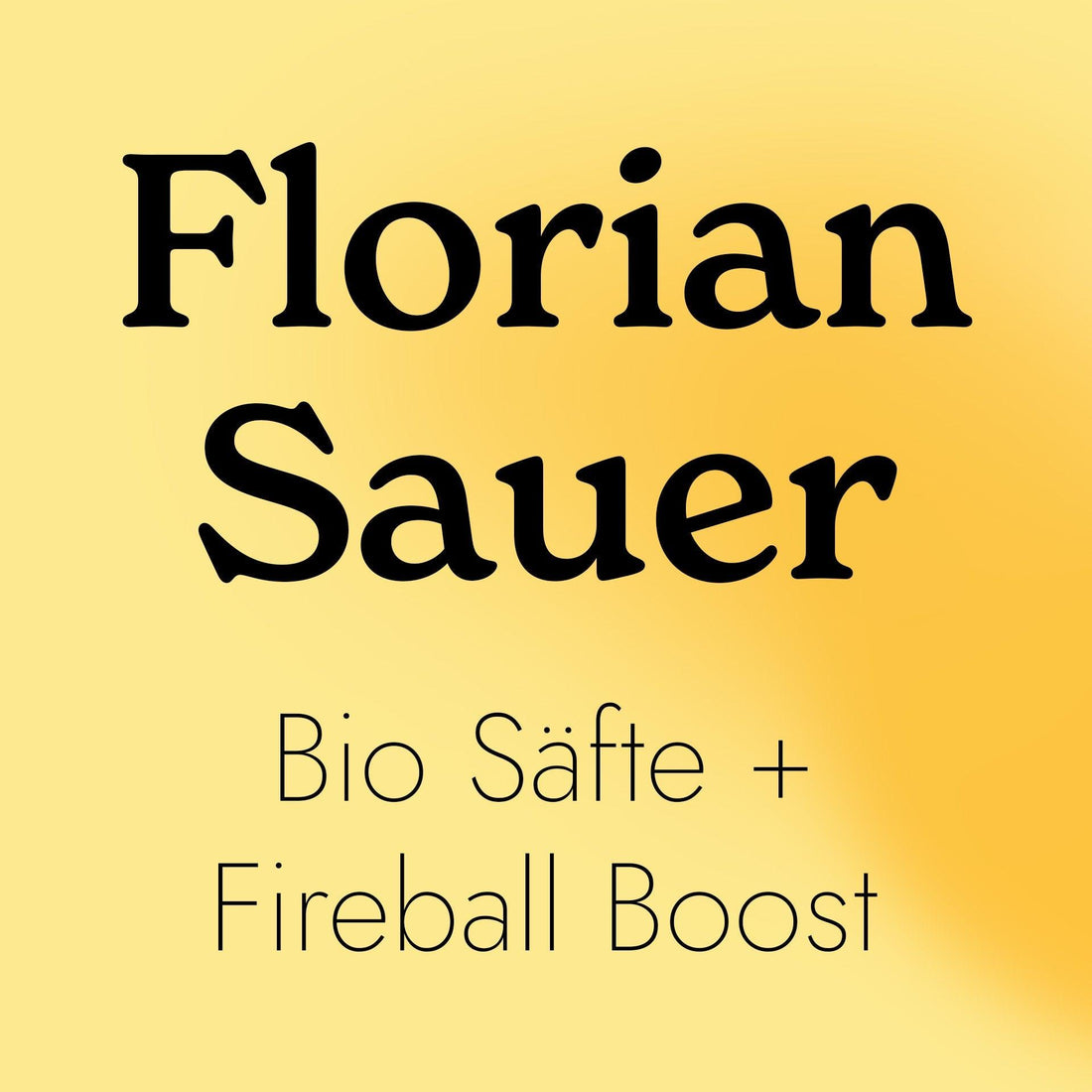In this article you will find one (or more) of the answers. The following food vocabulary list gives you a small overview of different labels, abbreviations and terms from the food and nutrition sector.
Plant-based = vegan = plant-based ?
Vegan
Lifestyle that excludes any consumption of animal products. And not only in terms of nutrition, but also in relation to clothing, make-up and in all other areas of life. Our I·DO juices and juice treatments are of course 100% vegan.
Plant-based
A diet based on plant-based, unprocessed foods. However, plant- based nutrition does not mean that animal products are completely avoided. Rather, milk, cheese or other products of animal origin are occasionally and consciously supplemented in addition to plant-based foods. This form of nutrition should therefore not be confused with veganism, in which animal products are completely excluded.
Gluten free
The term gluten comes from Latin and means something like "glue" or "glue". It describes a substance made of proteins, lipids and carbohydrates which, together with water, forms a rubbery mass when flour is made into a paste. Gluten is therefore of great importance for baking with flour . Gluten occurs naturally in most cereals such as wheat, barley, rye, spelt, emmer or unripe spelt. People with gluten intolerance, also known as celiac disease, must avoid all of these foods. Otherwise, the intestine would be damaged due to an inflammatory disease of the intestinal mucosa. There are naturally a number of foods that are gluten-free, such as corn, rice, millet, amaranth, quinoa, soy, buckwheat, potatoes, fruit, vegetables, legumes and many more. Other foods may be declared "gluten-free" if they contain less than two milligrams of gluten per 100 grams .
Lactose free
Lactose, also known as milk sugar, is a sugar that occurs naturally in milk. Lactose consists of two sugar molecules: mucus sugar (galactose) and glucose (dextrose). In the human body, the lactose is broken down into these two sugar parts by the enzyme lactase. About every seventh person in Germany suffers from milk sugar intolerance (lactose intolerance) and cannot digest lactose at all or only with difficulty. For this reason, there is a wide range of lactose-free milk products in which the milk sugar is already broken down. For milk products and cheese, the term "lactose-free" is regulated by law in Germany and allows a lactose content of less than 0.1 grams per 100 grams. A natural alternative to lactose-free cow's milk is of course also offered by all kinds of plant-based drinks that naturally contain no lactose .
low carb
As the English name suggests, low carb describes a diet that includes only a few carbohydrates.
Raw food
As the name suggests, raw food refers to the consumption of raw foods, such as uncooked vegetables, untreated nuts or anything else.
Slim Food
This term stands for foods with a low carbohydrate and fat content. This generally includes most fruits and vegetables, as well as legumes. Special slim foods are, for example, vegan foods such as chicory, white cabbage, lettuce, zucchini or mango.
umami
The word umami comes from the Japanese and means something like "tasty" or "delicious" and that's exactly what it's supposed to express. As early as 1908, the Japanese Kikunae Ikeda discovered this taste, which is seen as the fifth taste alongside sweet, sour, bitter and salty.
Umami describes a hearty, spicy, piquant taste and is mainly perceived in the throat area. Since the taste is created by the salts of the amino acid glutamate, we taste umami more often with protein-rich food. The naturally occurring glutamate is harmless and is found naturally in tomatoes, yeast, parmesan, beans and soy sauce, for example. The typical umami taste is particularly evident in the Japanese "Dashi" broth, which contains brown algae as a spicy ingredient.
organic
EU legislation defines certain production requirements for organic food. Bio therefore stands for pesticide-free, GMO-free cultivation with species-appropriate animal husbandry. Furthermore, organic products in the food sector may only contain a few additives, must be free from flavor enhancers, artificial aromas, stabilizers or synthetic sweeteners and 95% of the ingredients must come from organic farming . You can find more about the labeling of organically grown food in our magazine article on Bio & Bio-Siegel.
carbon footprint
In general, the carbon footprint is a measure of all emissions that are directly or indirectly caused by a specific activity. A carbon footprint can be calculated for countries, companies, products, services or people. For a product, all carbon dioxide emissions that arise during the manufacture, use and disposal of a product, as well as all raw materials and services required, are taken into account. You can also calculate your own carbon footprint very practically for you as a person.
Climate neutral
We are increasingly coming across the concept of climate neutrality when it comes to food. Basically, climate neutrality describes the balance between the emission of carbon in the form of greenhouse gases and their absorption from the atmosphere and the corresponding conversion or compensation. However, climate-neutral does not mean CO 2 -free. Activities or processes are only CO 2 -free if they do not cause any harmful CO 2 emissions throughout the process . For the production of food, it means for a company to be climate-neutral if all CO 2 emissions emitted for the production and sale of a product are offset by supporting climate protection projects .
We at I·DO produce all our juices 100% climate-neutral . We also support various climate protection projects both in Germany and worldwide.
The most important seals and logos
fair trade
Fairtrade is a certification system that identifies products and raw materials that come from fair trade. The Fairtrade standards are based on the Universal Declaration of Human Rights and other international agreements and are checked against specific criteria. Fairtrade offers farmers the opportunity to sell their goods under fair conditions and to cover the costs of sustainable production. The Fairtrade seal on products provides proof that economic, ecological and socially responsible criteria are observed during production. It goes without saying that our I DO mir was Gutes cotton bag bears the Fairtrade seal and is made from Fairtrade cotton.
GEPA
The term GEPA is derived from the name of the company at that time , the Society for the Promotion of Partnership with the Third World at the time the company was founded. Today GEPA calls itself - The Fair Trade Company and is the largest fair trade company in Europe. The main goals of GEPA are to educate consumers and to sustainably support producers in countries of the Global South. In addition, GEPA would like to contribute to changing unjust world trade structures through concrete alternatives, lobbying and political work. GEPA always reinvests its profits in fair trade, for example directly in the conversion to ecological cultivation of trading partners. All products managed by GEPA, such as coffee, tea, honey, chocolate and handicrafts, are 100% fair trade with the utmost respect for people and nature .
Without genetic technology
The “Ohne Gentechnik” seal , controlled by the Federal Ministry of Food and Agriculture , identifies food that is produced without the use of genetic engineering.
Without flavor enhancers
The note "without flavor enhancers" on a product packaging indicates that the product was manufactured without flavor-enhancing additives within the meaning of food law. A well-known flavor enhancer is glutamate, which enhances the flavor of other ingredients without having a flavor of its own. Flavor enhancers are to be viewed as very critical, as they disrupt the body's natural feeling of hunger and satiety. However, the flavoring substance glutamate can also be found in natural ingredients such as tomatoes, mushrooms, soy protein or yeast . Yeast extract, for example, adds a certain flavor to the food, namely the umami taste. Since yeast extract is made from processed natural yeast cells and is therefore of natural origin, it does not fall under the category of "flavor enhancers". Yeast extract can therefore be included as a flavoring ingredient under the claim "Without flavor enhancers". .
MSC
The MSC seal certifies fish and seafood from sustainable fisheries. The Marine Stewardship Council (MSC) is an international non-profit organization that campaigns against overfishing and the destruction of marine ecosystems. However, there are also critical voices about the MSC label, which, for example, question the regulations on permitted bycatch and stocks that are already overfished. However, critical voices are raised again and again - for example, that fisheries with high bycatch and even fish from overfished stocks can be labeled with the MSC seal.
FSC
Although the seal of the Forest Stewardship Council (FSC) does not identify any food itself, product packaging can be marked with it. The FSC seal is an international certification for sustainable forest management and proves that the wood used for the respective product comes from forests with environmentally friendly management. With environmentally friendly, socially just and economically viable use of the forest, a contribution should be made to the long-term preservation of the forests on our planet .
V label
Surely you have confused the two V-labels in the supermarket. There are two variants: the vegan label and the vegetarian label. The V-Labels are an internationally protected trademark for the uniform labeling of vegetarian and vegan products and services.
The vegetarian label stands for products without animal ingredients, whereby products from living animals such as milk, eggs or honey can be used.
Products marked with the vegan label , on the other hand, are made 100% without animal ingredients, processing aids, additives, carriers, flavors and enzymes. Thus, every step of the production chain from cultivation to delivery of food with this label is vegan.
Conclusion
Finding your way through the jungle of abbreviations, labels and designations for foods and forms of nutrition is not that easy. Even if vegan and organic are now an integral part of general usage, there are more differences than you might think.
We hope we were able to give you a rough overview of the most important vocabulary for the year 2023, so that you no longer get lost in the jungle of food terms :)


